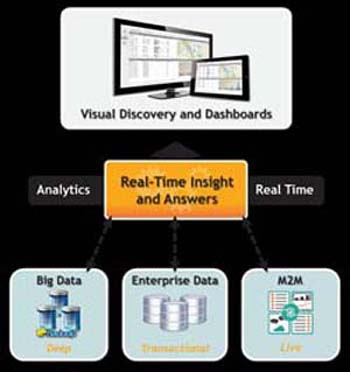Maximizing Value from M2M Data
But even organizations that have begun to integrate their M2M data with other enterprise systems are missing a key part of the M2M puzzle. Connecting real-time machine information with other current and past corporate information isn’t enough. What these businesses lack is the ability to see the combined data in interactive visual dashboards. Actually looking at the data, mashed together in a single view, can provide business users with powerful insights and actionable intelligence that don’t come from streams of sensor data alone. These insights can be applied to improve a variety of specific business programs, including preventive (and, ultimately, predictive) maintenance, quality assurance, usage assessment and diagnostic analytics.

Here are other key considerations for processing and consuming M2M data:
- Can business users build and customize dashboards quickly enough to support the immediate response time M2M will soon demand?
- Can new Big Data elements from M2M sources be delivered and integrated into the existing views for analysis without any delay?
- Once real-time visualizations are created, can those visualizations be accessed on mobile devices where appropriate?
- Can archival/historical data be connected to the real-time data to help visually identify trends and possible predictive metrics?
GE’s $1 Billion Investment for a 1% Gain
Making M2M data pay off means translating the data into improvements in efficiency. GE is forging this path by using big data analytics to predict maintenance needs, monitor all machines from afar in real time, and find new efficiencies through interconnected machine networks, in which the systems learn on their own by talking to each other.
At a recent conference, Bill Ruh, vice president of GE’s GlobalSoftwareCenter, told the audience that GE is investing $1 billion in software over the next four years to read and analyze the machine data produced by the heavy machinery it sells.
According to Ruh, even modest gains in efficiency can be a huge boost to profits. For example, a 1% efficiency gain for its airplane engines could result in $30 billion in savings in fuel costs for commercial airlines. The same one percent improvement for natural gas-firing generators could produce savings of $66 billion.